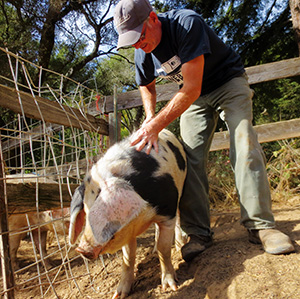

Daniel Maxfield rolled up to his ranch a couple weeks ago to find a passel of pigs he relegated to one oak-forested corner of the property roaming free. He’d put up an electric fence to keep them in a woodsy expanse so they could forage for acorns and roam around pasture. But the pigs collectively decided to brave the shock and trundle on through the electrified barrier.
“They do what they want around here,” says Maxfield, stomping his heavy work boots along the dirt path to the breached wire enclosure. “I’ve got to start over now, teach them to respect the fence.”
Maxfield’s pigs—some black, some pink with black spots, all with big floppy ears over their eyes—are especially free-spirited. When they’re not foraging for apples, acorns, grass and plums and toppling electric fences, they lounge around in oak- and redwood-shaded patches of Mountain Whale Ranch, a 60-acre homestead deep in the Santa Cruz Mountains. “The happiest pigs in the world,” boasts Maxfield, who drives the half-hour every morning from his home in Los Gatos to the pig ranch where he spends most of his waking hours with his fat, happy wards.
Because they live such a fulfilling life, customers pay a premium for their meat. Up to $1,500 a carcass, depending on its age and how much of that prime grain feed it gobbled up. A full-bellied hog, perfect for bacon, is a little pricier because it has to mature a little longer and requires more feed. A good roaster, which tends to be a bit leaner, goes for about $1,000.
Despite the cost, every pig on the ranch is spoken for, some sold to restaurants including the chef-owned Hay Market in San Jose and the Oak and Rye in Los Gatos.
“This is quite different from commodity pork,” says Maxfield, perched on a dinged-up stool near the open-air slaughter station, where he rubs the hog bellies to lull them before the kill. (Any hint of stress toughens the meat, which means they can never know when death is nigh.) “The quality of fat is extraordinary—the best fat—not that bright white you normally see, but more of a brown color.” Unlike those pink, antibiotic-pumped cuts from the supermarket, Maxfield’s meat is “red, almost beefy.” He breeds a cross of Gloucester Old Spot and Mulefoot hogs—both natural foragers that thrive in forests and produce nutrient-dense meat with flavorful lard—a mix he calls Mulespots.
“From the time that mama gets pregnant to when the meat ends up on my fork—that’s a year,” he says. “The entire time, we make sure it lives a stress-free existence to get the best possible product. That’s what I want to eat.”
Growing up on a farm in the Utah mountains, Maxfield tended pigs from a young age. His family was poor, raising the hogs to eat.
“We’d breed every year,” he says. “Sell to everyone else, keep one for ourselves.”
He always liked the hogs because they were smart and social, with personalities a lot like a dog. They have a range of expression other livestock seem to lack. He hated seeing them cooped up.
“They weren’t abused, but they weren’t on pasture,” he says. “They were kept in confinement, in these horrible little pens.”
When he was 15, Maxfield left the family farm. Eventually, he wound up in California, and after a decades-long career in healthcare and a stint at San Jose’s Tech Museum, he fell back to his roots. Laid off from the museum in 2008, a casualty of the recession, he began volunteering at Love Apple Farm, a micro-farm in the Santa Cruz mountains. The pigs started out as a little side project until Maxfield landed the ranch in 2012 thanks to a charitable landlord who offered the mountain acreage up for a cheap lease. The moniker came from a recipe in an old cookbook that called for “mountain whale,” what Japanese monks called wild boar.
“It stood out to me,” Maxfield says. “Also because the book Moby Dick had such an impact on me when I was younger. Farming life, on this micro-scale, is like chasing a big, white whale. I knew that then and I experience that now.”
Pork, he insists, is good for the planet in a way beef can never be. Pigs have a smaller footprint and more utility—virtually every part, snout to tail, is usable.
“With a cow, they take up so much space,” says Maxfield. “And their head is huge, but you can’t really use that. Well, most people don’t, except in some French cuisine.”
Maxfield’s way may not be the most profitable—he’d be in the black if he bought a lesser-grade feed—but it’s the only way he’ll eat it, thus the only way he’ll sell it.
“It’s a rebellious act,” he says. “You have to be a little nuts to be a chef and buy a whole pig, to extract the value out of a whole carcass. You need flexibility on your menu, to say that no we can’t just have cheek meat. You got to have just ‘pig’ on the menu, and create something around that. Make it worthwhile.”



